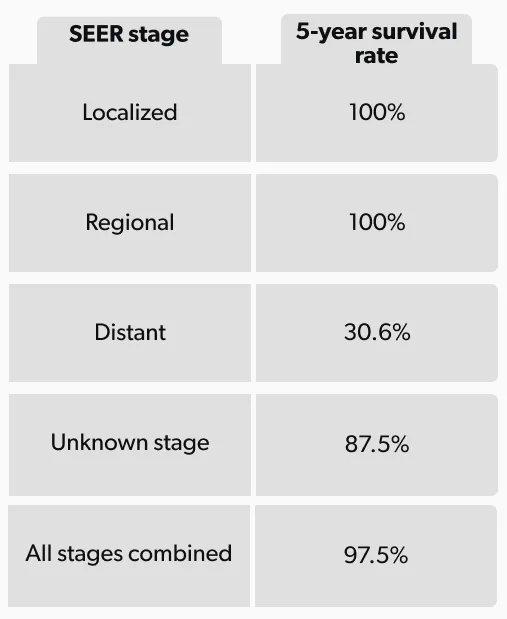Here's what we'll cover
Here's what we'll cover
Prostate cancer is one of the most feared diagnoses in men. It’s the most common cancer for men aside from skin cancer—about 1 in 8 men will be diagnosed with it in their lifetime. It’s also the second leading cause of cancer death in American men following lung cancer, according to the American Cancer Society. In the United States, it’s estimated that there will be 248,530 new cases of prostate cancer diagnosed in 2021 and 34,130 men will die from the disease (ACS-a, 2021).
While that sounds grim, prostate cancer survival rates show that most men will not die from the disease. Early detection of prostate cancer makes it very treatable.
Survival rates for prostate cancer
The overall 5-year relative survival rate for prostate cancer in the United States is 98%. This means that if you combine the survival rates for all stages of prostate cancer, men with it are 98% as likely as those without the disease to be alive five years following diagnosis (ACS-b, 2021).
That’s a pretty good statistic compared to other cancers. For example, the overall 5-year survival rate for pancreatic cancer—one of the most aggressive cancers out there—is only 10%. Typically, survival statistics are broken down based on how advanced the cancer is. In most cases, the more aggressive or advanced the disease (meaning it’s spread to other parts of the body), the lower the survival rate.
The same is true for prostate cancer. There are many different ways for healthcare providers to describe how aggressive a cancer is at diagnosis. Here is how prostate cancer is grouped, according to the National Cancer Institute’s Surveillance, Epidemiology, and End Results Program (SEER) (ACS-b, 2021):
Localized: Cancer has not spread beyond the prostate. In this early stage, treatment is often successful.
Regional: Cancer has spread outside of the prostate to adjacent structures and lymph nodes.
Distant: Also called metastatic prostate cancer, this is the most advanced stage of disease. It means the cancer has spread to distant parts of the body, including the bones, liver, and lungs.
Here’s a look at the 5-year survival rates for men with prostate cancer, based on SEER’s database information.

What do cancer survival rates mean?
For people with cancer, these statistics are more than just numbers. When someone gets a cancer diagnosis, hopes and fears are often projected into survival rate statistics.
As we mentioned, cancer survival rates describe the percentage of people still alive five years after their initial diagnosis. For example, if the 5-year survival rate for a specific stage of cancer is 50%, it means whoever has that cancer is 50% as likely as someone without it to live for at least five years after being diagnosed.
Whatever statistics you read online, be aware that these numbers come from studies with large numbers of people. They can’t predict future health or well-being for just one person as each individual responds to cancer and treatments for it differently. That also means some men recently diagnosed with prostate cancer may have an even better outlook than the numbers indicate.
Remember: survival rates for prostate cancer are not a definitive prediction. The numbers merely reflect the trends seen in other men in similar stages of disease. Survival rates also don’t take prostate-specific antigen (PSA) levels, response to prostate cancer treatment, or progression of disease into account.
It’s important to remember that prostate cancer can be a serious disease, but most men diagnosed with prostate cancer do not die from it. More than 3.1 million men in the United States who have been diagnosed with prostate cancer at some point are still alive today.
Prostate cancer survival rate numbers can be confusing and may leave you with more questions. It is essential to discuss your particular situation with a healthcare provider who can help you understand your condition and work with you to develop a treatment plan.
DISCLAIMER
If you have any medical questions or concerns, please talk to your healthcare provider. The articles on Health Guide are underpinned by peer-reviewed research and information drawn from medical societies and governmental agencies. However, they are not a substitute for professional medical advice, diagnosis, or treatment.
American Cancer Society (ACS-a). (2021). Key statistics for prostate cancer: prostate cancer facts. Retrieved May, 7 from https://www.cancer.org/cancer/prostate-cancer/about/key-statistics.html
American Cancer Society (ACS-b). (2021). Survival Rates for Prostate Cancer. Retrieved from https://www.cancer.org/cancer/prostate-cancer/detection-diagnosis-staging/survival-rates.html












